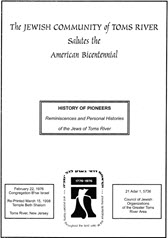THE PINCUS FAMILY (May 1971)
In another 7 months it will be 50 years since we have settled in Toms River. In 1921, the town and township had a population of 1700-1800 (now over 40,000). The streets were unpaved and often muddy with hitching posts on Main and Washington Streets and only one block of shopping places.
We were among the first of a wave of Jewish farmers, all starting a new life on land on a shoestring. If there are any analogies to be drawn with the first "halutzim" in Israel, it is sameness of ideas. To build a new life on land.; to escape the dreary city life in shops and so-called "businesses in the ghettos".
Even before these pioneers were established as self sustaining farmers, and everyone built and expanded and lived on credit, they built a Community Center embracing a synagogue, a children's Yiddish school, a center for cooperation and cultural activities (as well as social life).
We, the Pincus' came to Toms River as hardened workers of the land. I went through a two year course in Agriculture in the Baron De Hirsh Agriculture School in Woodbine, NJ and became a wandering farm worker on 17 farms in 9 states from coast to coast.
We settled on our first farm (two brothers) near Flemington, NJ (on a general farm) . Two years later we came by ourselves to Toms River.
My life partner, Clara, had by that time developed a love of land, of creative farming, animals, vegetables, fruit trees and particularly flowers. The beauty of the fields and woods, sunrises and sunsets of every season have for many years (to this day) compensated for many tight situations and difficulties in which all newcomers to the Jewish Community were cheerful companions.
It didn't take long and Clara was teaching her gentile neighbors how to raise flowers, how to care for hens, and how to can and preserve fruits and vegetables . She received her first blue ribbons for flowers and preserves at the first County Fair in Beachwood (in the early 20's). At the same time she participated in the cultural and social life in the growing community; the Ladies auxiliary, the Folk Shule, etc. Our son was born in 1925. She raised him to a fine man, a good Jew and lover of land.
The building of farm and home has not deterred me from full scale participation in building the Jewish Community. I have served as three time (7 years) President of the Community of Jewish Farmers as well as recording secretary and member of the executive board for tens of years. I directed the Yiddish Folk Shule, formed the Yiddish dramatic club, presented several one act plays and community sings. I served as President of the first Jewish Feed Cooperative: the first Breed Improvements Group (we had 10 pens of pullets in the state laying contest). We had on our farm the champion white leghorn with 311 Eggs). I served as secretary of the White Oak Cooperative, the Federal Farmers Credit Union and the Federated Egg Producers Cooperative. I served on the Executive Board of the Ocean County Board of Agriculture. I served as chairman of the Patrons Committee of the White Oak Cooperative G.L.F. for 9 years; as director of the Federal Land Bank, as member of the Farm Home Administration Committee, as member of the Coordinating Price Control Committee going to Washington, D.C. to boost egg prices through Government purchases.
Last but not least was leading a movement for the White Oak Cooperative for a Municipal Electric Plant in Dover Township. It was voted down in a referendum after a stiff fight. The archives (records and press releases, etc.) of the Community of Jewish Farmers are now in the Yiddish Scientific Institute in New York City, and have been used already by a writer of a book about the South Jersey Jewish Farm Colonies. Adding the participation in drives for Ambijau (the false dream) and various campaigns for Israel, it looks in retrospect like a worthwhile pastime.
Now being retired from actual farming, we are still the enthusiastic nature lovers as in our youth. And what could be more soul satisfying than watching a seed sprout and grow into a flower or vegetable, watching a tree (a blue spruce) grow from a six to eight inch stripling grow into a twenty foot beauty; watching a mighty oak tree (on our front lawn) stricken by lightning and dying from the top, come to life again and grow a new crown; watching white sand field growing nothing but pesky weeds grow darker and fatter after cultivation and heavy with good vegetation and fruitfulness.
This is the joy of farming and merging with nature that inspired tens of thousands of Jews in colonies in Israel, in the USA, in Argentina or Crimea. It shall never be forgotten.
A. Pincus
Jan. 18, 1976
